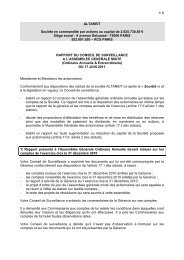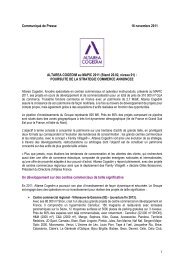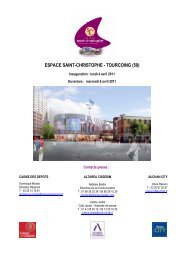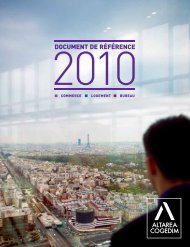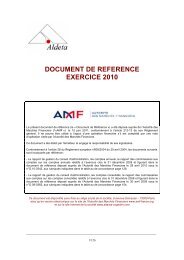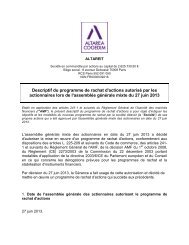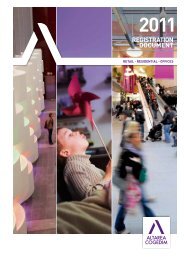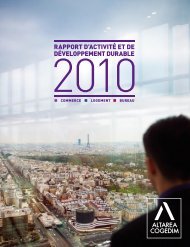Annual report 2008 - Altarea Cogedim
Annual report 2008 - Altarea Cogedim
Annual report 2008 - Altarea Cogedim
Create successful ePaper yourself
Turn your PDF publications into a flip-book with our unique Google optimized e-Paper software.
The instability of the capital markets has triggered a<br />
reduction in the number of transactions in the property<br />
market and exacerbated the difficulty of forecasting the<br />
prices that may be secured from putting a real estate<br />
asset up for sale. Given this period of greater-than-normal<br />
uncertainty, appraisers have reacted by analysing carefully<br />
the transactions that have taken place and by reviewing all<br />
the assumptions used (discount and capitalisation rates,<br />
rental value, vacancy, etc.) to determine the fair value of<br />
the property assets.<br />
7.13. Assets under development<br />
Assets under development correspond to programmes to<br />
develop new shopping centres and programmes to expand<br />
or restructure existing shopping centres that are not yet<br />
back in operation. In accordance with IAS 16, assets under<br />
development are measured at cost.<br />
Owing to the economic and financial crisis, the measurement<br />
of the recoverable amount of these properties under<br />
development at the balance sheet date entailed the use<br />
of assumptions and estimates given the scarcity of the<br />
properties traded, which made measurements difficult, and<br />
the possibility of a decline in the commercial potential of<br />
locations as a result of the possible impact of the economic<br />
crisis on consumer spending.<br />
On these programmes, the costs incurred, including the cost<br />
to acquire land, are capitalised from the time the programme<br />
begins with the prospecting phase (the period of responding<br />
to requests for bids, prior to signing option contracts to<br />
buy land), provided there is reasonable assurance that the<br />
necessary administrative authorisations will be obtained.<br />
These costs are primarily:<br />
• design and management fees, both internal and external<br />
to the Group,<br />
• legal fees,<br />
• demolition costs (if applicable),<br />
• construction costs,<br />
• finance costs in line with the revised IAS 23.<br />
Costs incurred on shopping centre development transactions<br />
for mainly investment purposes are recognised as assets under<br />
development until the programme is completed. Where there<br />
is a delay in the start of construction of the development or<br />
any other evidence of impairment, management assesses on<br />
a case-by-case basis the grounds for recognising impairment<br />
of all or some of the costs incurred.<br />
The internal fees are primarily programme management<br />
fees (management of filings until permits are obtained)<br />
and project management fees, which from an economic<br />
standpoint are components of the cost of the asset and<br />
are thus included in the carrying amount (in non-current<br />
assets or inventory, as the case may be). The amount of fees<br />
included is calculated after elimination of intercompany<br />
profit margins.<br />
The recoverable amount of these assets is assessed by<br />
comparison with the cost to completion and with the<br />
estimated value of expected future cash flows.<br />
The transfer to investment property is made when<br />
the shopping centre is opened (specifically, when the<br />
Declaration of Completion and the compliance and safety<br />
certificates, generally issued by the municipal administrative<br />
departments, have been obtained). When a shopping centre<br />
is delivered in stages, the opening date is determined based<br />
on the existence of assets that can be valued individually by<br />
an external appraiser or when more than half of the property<br />
has entered service.<br />
7.14. Non-current assets held for sale<br />
and discontinued operations<br />
In accordance with IFRS 5, a non-current asset is classified<br />
as “held for sale” if its carrying amount is to be recovered<br />
primarily through a sale transaction rather than through<br />
ongoing use.<br />
This is the case if the asset is available for immediate sale<br />
in its current state, subject only to the usual and customary<br />
conditions for the sale of such an asset, and if its sale is<br />
highly probable.<br />
Indications of a high probability of sale include the existence<br />
of a plan by the Group’s management to sell the asset and<br />
an active programme to find a buyer and close a sale within<br />
the next 12 months.<br />
The part of this standard relating to measurement rules<br />
applies only to assets not measured using the fair value<br />
method for investment properties. On the other hand, all<br />
assets, including assets where a sale is highly probable, are<br />
classified on the balance sheet as assets held for sale.<br />
There are no discontinued activities to be noted in the<br />
financial year for the Group.<br />
91



